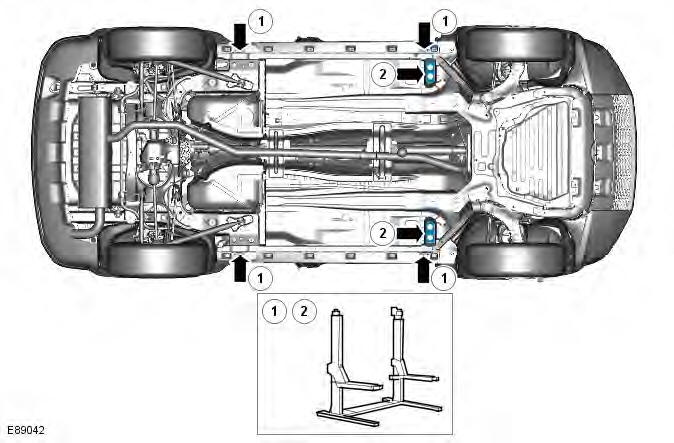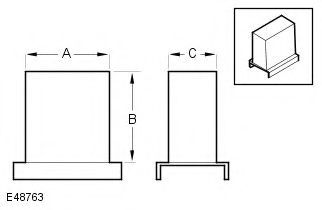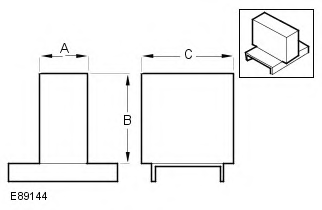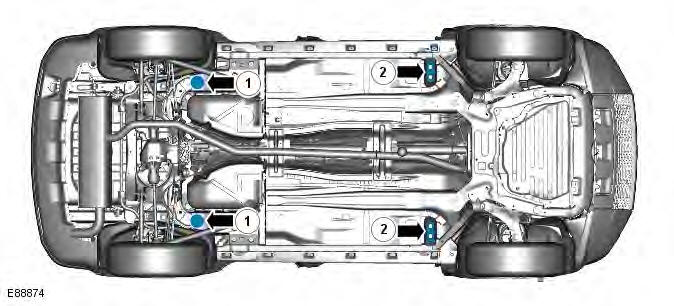Range Rover Evoque: Lifting
Two-Post Lift
 WARNING:
Make sure that the vehicle is stable before commencing work.
WARNING:
Make sure that the vehicle is stable before commencing work.
 CAUTION: If
the drive shaft(s) are to be removed, release the parking brake and select
NEUTRAL 'N' in the
transmission in order that the shaft(s) can be rotated when the vehicle is
raised to the desired height.
CAUTION: If
the drive shaft(s) are to be removed, release the parking brake and select
NEUTRAL 'N' in the
transmission in order that the shaft(s) can be rotated when the vehicle is
raised to the desired height.
1. Position the vehicle with the centre of the lift pillars aligned approximately with the front of the driver/passenger seat cushions.

- Two post lift locations - Customer jacking points
- Optional, Two-post front lift locations - Body mounting used in vehicle production
2. Extend the lifting arms and position the pad of each lifting arm beneath the approved points.
3. Raise the vehicle until the wheels are just clear of the ground and check that the pads of each lifting arm are still correctly positioned.
4. Raise the vehicle to the desired height.
5. Ensure the vehicle is correctly supported with the lifting pads in full contact with the approved points.
Vehicle on wheels - Four-Post Ramp
 WARNINGS:
WARNINGS:
If the drive shaft(s) are to be disconnected, it will be necessary to raise all four wheels off the ramp in order that the shaft(s) can be rotated. Refer to the 'Wheel Free Lift - Four-Post Ramp' section below for lifting instructions then release the parking brake and select NEUTRAL in the transmission.
Do not push the vehicle backwards and forwards along the ramp in order to gain access to the drive shaft fixings.
Position the vehicle on the ramp with the front and rear wheels equidistant from the ends of the ramp. Chock the wheels, select NEUTRAL in the transmission and where practical, apply the parking brake.
Wheel-Free Lift - Four-Post Ramp
 NOTE: To enable
the vehicle to be supported correctly on the wheel-free longitudinals, it will
be necessary to produce
2 off each of the support blocks to the dimensions given in the accompanying
illustrations. The supporting part of each
block must be manufactured from suitable hardwood or metal and the 'U' shaped
base of each block must be manufactured
from metal. Note that it is essential to ensure that the 'U' shaped base of each
block is wide enough to fit over the wheel
free longitudinals.
NOTE: To enable
the vehicle to be supported correctly on the wheel-free longitudinals, it will
be necessary to produce
2 off each of the support blocks to the dimensions given in the accompanying
illustrations. The supporting part of each
block must be manufactured from suitable hardwood or metal and the 'U' shaped
base of each block must be manufactured
from metal. Note that it is essential to ensure that the 'U' shaped base of each
block is wide enough to fit over the wheel
free longitudinals.
Front support block dimensions

- 130 mm (5.118 in)
- 160 mm (6.299 in)
- 90 mm (3.543 in)
Rear support block dimensions

- 50 mm (1.1968 in)
- 190 (7.480 in)
- 110 (4.330 in)
Raising and Supporting the Vehicle
1. Position vehicle on ramp.
2. Apply parking brake.
3. Raise ramp to required height 4. Align the wheel-free longitudinals and position the support blocks beneath the positions shown

Engage wheel-free and lower ramp until weight of vehicle rests on support blocks and road wheels are just clear of ramp.
Ensure that vehicle is correctly supported on all four support blocks, that blocks are still correctly positioned and are in full contact with the body mounting points.
 WARNING:
Make sure that the vehicle is stable before commencing work
WARNING:
Make sure that the vehicle is stable before commencing work

